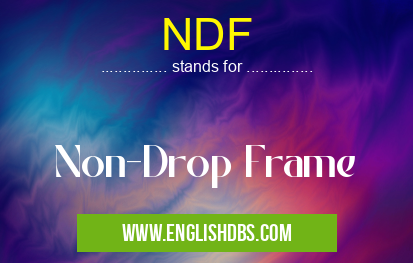What does NDF mean in HARDWARE
NDF stands for Non-Drop Frame in computing. It is a timecode format used to determine the length of video or audio recordings. NDF is used mainly in the television industry, although it is also popular in other media applications such as digital media production and music recording. NDF, unlike its counterparts such as Drop Frame and Binary Coded Decimal (BCD) formats, does not drop or omit any frames when counting timecode. This makes it useful for operations that require accurate timing measurements such as broadcasting. The rate of timecode in an NDF system is 30 frames per second, which is the same rate used by NTSC systems in the US and Canada.

NDF meaning in Hardware in Computing
NDF mostly used in an acronym Hardware in Category Computing that means Non-Drop Frame
Shorthand: NDF,
Full Form: Non-Drop Frame
For more information of "Non-Drop Frame", see the section below.
What Does NDF Stand For?
When referring to timecodes, NDF stands for Non-Drop Frame and it refers to a specific type of timecode format that counts each frame without dropping any. Unlike Drop Frame or Binary Coded Decimal (BCD) formats which omit some frames when counting a span of time, NDF will accurately count all 30 frames per second without omitting any frames from the count. This makes it useful for operations that require precise timing accuracy like broadcasting where missing or incorrect timing data can cause disruption to programmes.
What Is The Use Of An NDF Format?:NDF formats are mainly used in the television industry where they are used to measure the exact length of time taken by video and audio recordings accurately. However, this format has also become popular among those involved in digital media production and music recording. An advantage of using an NDF system is that when operating at 30 frames per second rate, there’s no need to jump from one frame rate tape speed setting to another while transferring material from one medium to another like from film stock to tape or vice versa; this would save on labour costs associated with manually changing tape speeds during transfers.
Essential Questions and Answers on Non-Drop Frame in "COMPUTING»HARDWARE"
What is Non-Drop Frame (NDF) timecode?
Non-Drop Frame (NDF) timecode is a type of SMPTE timecode that counts frames without the use of drop frames, or periods of time where frames are not counted. NDF is the original form of SMPTE timecode, and is often used as the reference for other types of frame rate conversions.
What are the advantages of using Non-Drop Frame Timecode?
One advantage of using NDF timecode is that it allows for more accurate representation of timestamp at a given frame rate or tempo. It does not account for any dropped frames, which makes it simpler and easier to use than its counterpart, Drop Frame (DF) timecode. In addition, NDF can be used as a basis for synchronization between different media systems since it doesn’t include any dropped frames that would cause discrepancies.
How does Non-Drop Frame (NDF) differ from Drop Frame (DF)?
The main difference between Non-Drop Frame (NDF) and Drop Frame (DF) is in how they count frames. With NDF, all the frames are counted linearly; whereas with DF, some certain parts of an hour—indicated by certain numbers on the clock—are skipped so that the media doesn't run too fast or too slow in relation to real world time.
Is it better to use one form over another?
It depends on what you’re trying to accomplish and what kind of precision you need from your timing information. If accuracy and precision in measuring times are important then you probably want to use DF; however if simply representing timestamps as close to real world times without any discrepancies then you'll want to use NDF instead.
What type of programs may require Non-Drop Frame Timecodes?
Non-Drop Frame Timecodes can be used in various programs and applications such as film production, video editing software, professional broadcast systems and media streaming services; all which require accurate representations of timestamps or durations with no discrepancies.
Are there any limits when using Non-Drop Frame Timecodes?
Generally, there aren't any limits when using NDF; however if you're dealing with very long lengths such as multiple hours then this may cause problems since each hour mark must be accounted for accurately which could result in discrepancies over extended lengths of time.
Is Non-Drop Frame (NDF) compatible with other types of Timecodes?
Yes, NDF is compatible with other types of SMPTE Timecodes such as Drop frame (Df), but any discrepancies may occur during frame rate conversion due to skipped frames caused by the DF system.
Final Words:
Non-Drop Frame (NDF) is a type of timecode format used primarily within the television industry to measure the exact duration of video and audio recordings precisely while also remaining consistent with accepted standard framerates across multiple platforms like NTSC systems in the US and Canada. It has become increasingly popular among digital media producers and music recordists due its accuracy, precision and compatibility with different formats during material transfer operations thus eliminating labour costs normally attributed with manual speed changes during successful transfers between films stocks and tapes etc .
NDF also stands for: |
|
| All stands for NDF |
